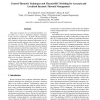Free Online Productivity Tools
i2Speak
i2Symbol
i2OCR
iTex2Img
iWeb2Print
iWeb2Shot
i2Type
iPdf2Split
iPdf2Merge
i2Bopomofo
i2Arabic
i2Style
i2Image
i2PDF
iLatex2Rtf
Sci2ools
122
click to vote
HPCA
2002
IEEE
2002
IEEE
Control-Theoretic Techniques and Thermal-RC Modeling for Accurate and Localized Dynamic Thermal Management
This paper proposes the use of formal feedback control theory as a way to implement adaptive techniques in the processor architecture. Dynamic thermal management (DTM) is used as a test vehicle, and variations of a PID controller (Proportional-Integral-Differential) are developed and tested for adaptive control of fetch “toggling.” To accurately test the DTM mechanism being proposed, this paper also develops a thermal model based on lumped thermal resistances and thermal capacitances. This model is computationally efficient and tracks temperature at the granularity of individual functional blocks within the processor. Because localized heating occurs much faster than chip-wide heating, some parts of the processor are more likely to be “hot spots” than others. Experiments using Wattch and the SPEC2000 benchmarks show that the thermal trigger threshold can be set within 0.2¢ of the maximum temperature and yet never enter thermal emergency. This cuts the performance loss of DTM...
Related Content
| Added | 14 Jul 2010 |
| Updated | 14 Jul 2010 |
| Type | Conference |
| Year | 2002 |
| Where | HPCA |
| Authors | Kevin Skadron, Tarek F. Abdelzaher, Mircea R. Stan |
Comments (0)

